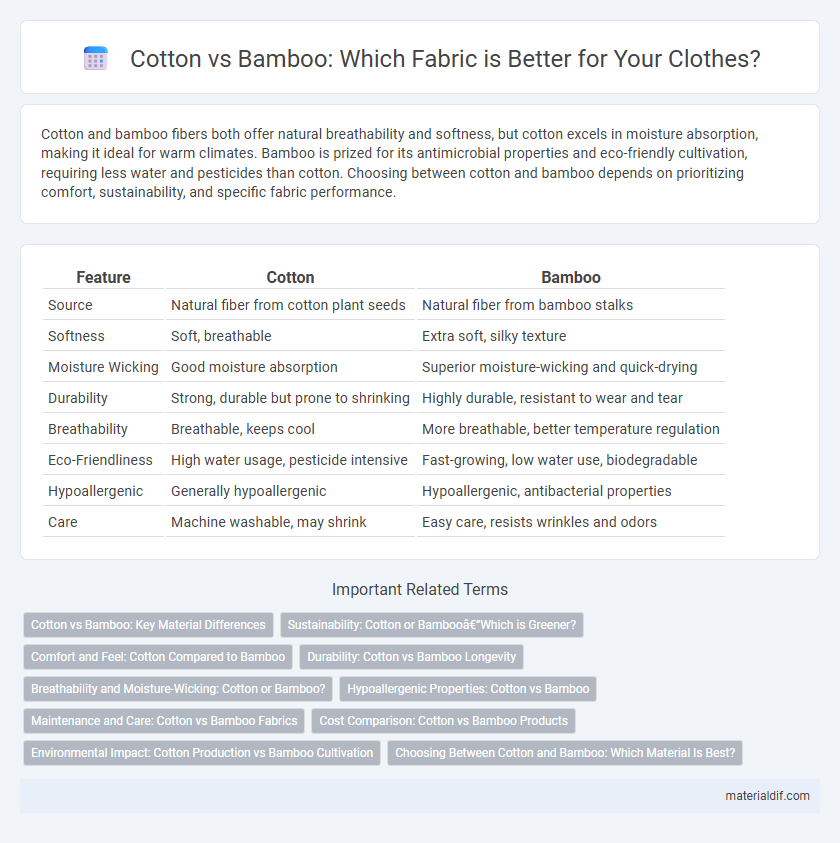Cotton and bamboo fibers both offer natural breathability and softness, but cotton excels in moisture absorption, making it ideal for warm climates. Bamboo is prized for its antimicrobial properties and eco-friendly cultivation, requiring less water and pesticides than cotton. Choosing between cotton and bamboo depends on prioritizing comfort, sustainability, and specific fabric performance.
Table of Comparison
| Feature | Cotton | Bamboo |
|---|---|---|
| Source | Natural fiber from cotton plant seeds | Natural fiber from bamboo stalks |
| Softness | Soft, breathable | Extra soft, silky texture |
| Moisture Wicking | Good moisture absorption | Superior moisture-wicking and quick-drying |
| Durability | Strong, durable but prone to shrinking | Highly durable, resistant to wear and tear |
| Breathability | Breathable, keeps cool | More breathable, better temperature regulation |
| Eco-Friendliness | High water usage, pesticide intensive | Fast-growing, low water use, biodegradable |
| Hypoallergenic | Generally hypoallergenic | Hypoallergenic, antibacterial properties |
| Care | Machine washable, may shrink | Easy care, resists wrinkles and odors |
Cotton vs Bamboo: Key Material Differences
Cotton is a natural fiber harvested from the seed hairs of the cotton plant, known for its breathability, softness, and moisture absorption, making it ideal for clothing and textiles. Bamboo fiber, derived from bamboo pulp, offers inherent antibacterial properties, quick-drying capabilities, and a silky texture but requires chemical processing for fiber extraction. Cotton's cultivation demands significant water usage and pesticides, whereas bamboo grows rapidly with minimal resources, impacting environmental sustainability differently.
Sustainability: Cotton or Bamboo—Which is Greener?
Cotton and bamboo differ significantly in sustainability, with bamboo generally considered greener due to its rapid growth rate and minimal need for pesticides or fertilizers. While organic cotton reduces environmental impact by eliminating harmful chemicals, conventional cotton cultivation often involves high water usage and soil degradation. Bamboo's ability to regenerate quickly and its lower resource demands make it a more eco-friendly option in textile production compared to traditional cotton farming.
Comfort and Feel: Cotton Compared to Bamboo
Cotton offers a soft, breathable texture that adapts well to body temperature, making it comfortable for various climates. Bamboo fabric, while also soft and smooth, tends to have a silkier feel and natural moisture-wicking properties that enhance comfort in humid conditions. Compared to bamboo, cotton provides a more traditional, plush feel favored for its durability and ease of care in everyday textiles.
Durability: Cotton vs Bamboo Longevity
Cotton fibers exhibit greater durability compared to bamboo, maintaining fabric integrity after numerous wash cycles due to their strong cellulose structure. Bamboo textiles tend to degrade faster because their fibers are softer and more prone to wear and tear over time. For long-lasting garments and textiles, cotton offers superior longevity, making it a preferred choice for durable clothing and household items.
Breathability and Moisture-Wicking: Cotton or Bamboo?
Bamboo fibers offer superior breathability compared to cotton due to their micro-gaps and micro-holes, allowing better air circulation and faster moisture evaporation. Cotton, while breathable, tends to retain more moisture, which can lead to a damp, heavy feel during extended wear. For activewear and hot climates, bamboo's moisture-wicking properties provide enhanced comfort by keeping the skin dry and cool.
Hypoallergenic Properties: Cotton vs Bamboo
Cotton and bamboo fibers both exhibit hypoallergenic properties, but bamboo is naturally resistant to bacteria and fungi, reducing allergen buildup more effectively than cotton. Cotton, while breathable and soft, may retain more moisture, potentially fostering allergens in sensitive skin. Bamboo's antimicrobial qualities make it a preferred choice for those with allergies or sensitive skin conditions.
Maintenance and Care: Cotton vs Bamboo Fabrics
Cotton fabrics require regular washing at higher temperatures to maintain hygiene and often need ironing to prevent wrinkles, making their care more labor-intensive compared to bamboo. Bamboo fabrics benefit from natural antibacterial properties, allowing for less frequent washing and deep cleaning, and their inherent softness reduces the need for additional fabric treatments. Both materials are durable, but bamboo maintains its softness and color retention longer with minimal maintenance.
Cost Comparison: Cotton vs Bamboo Products
Cotton products generally cost less than bamboo products due to lower raw material and processing expenses. Bamboo textiles require more specialized manufacturing techniques, which increase production costs and retail prices. Consumers often face price premiums on bamboo items despite their eco-friendly benefits compared to conventional cotton goods.
Environmental Impact: Cotton Production vs Bamboo Cultivation
Cotton production requires significant water usage, with an average of 20,000 liters needed to produce one kilogram of cotton, contributing to water scarcity in arid regions. Bamboo cultivation demands less water and grows rapidly without pesticides, making it a more sustainable option that helps prevent soil erosion and carbon dioxide accumulation. However, cotton fields support diverse ecosystems and are essential for the livelihoods of millions of farmers worldwide, balancing environmental concerns with socio-economic factors.
Choosing Between Cotton and Bamboo: Which Material Is Best?
Cotton offers natural breathability and softness, making it ideal for sensitive skin and everyday wear, while bamboo excels in moisture-wicking and antibacterial properties, providing enhanced comfort in hot and humid conditions. Cotton fabrics tend to be more durable and widely accessible, whereas bamboo textiles are praised for their eco-friendly production and silky texture. Choosing between cotton and bamboo depends on prioritizing sustainability, moisture management, and fabric feel for specific uses like bedding, clothing, or towels.
Cotton vs Bamboo Infographic

 materialdif.com
materialdif.com